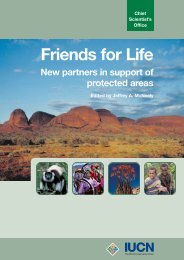Exchange programmes - IUCN
Exchange programmes - IUCN
Exchange programmes - IUCN
Create successful ePaper yourself
Turn your PDF publications into a flip-book with our unique Google optimized e-Paper software.
� language(s) spoken;<br />
� geographical location; and<br />
� social and cultural similarities and differences.<br />
The amount of time that can be spent on the planning process (identified in Stage 1)<br />
will also help determine who might be appropriate partners. For example, if limited time,<br />
funding and personnel are available, it might be best to stick to local or regional partners,<br />
as distance often has a relationship to the amount of time and energy required to establish<br />
and maintain a partnership. However, communication advances such as e-mail and fax<br />
machines, have lessened the tyranny of distance for park managers – but only if they<br />
have access to these technologies.<br />
Two additional variables appear to be critical when selecting potential partners. First,<br />
a mutual respect for each other’s culture, language, expertise and contribution to the<br />
partnership is essential. Second, it must be clear that each partner will benefit from the<br />
exchange. It may therefore be useful to include a statement within the MOU or other<br />
documentation (Stage 6) of exactly how each partner will benefit from the exchange<br />
activities.<br />
Stage 4. Identify type(s) of exchange(s)<br />
Recommendations for protected area exchanges in East Asia<br />
Section 1.4 of this report identified a variety of possible types of exchange <strong>programmes</strong>:<br />
individual exchanges and partnering, twinning or sistering, training seminars, group<br />
visits and international collaboration. In general, these types of programme are listed in<br />
increasing order of effort and funding required. Thus individual visits are normally the<br />
easiest and cheapest to arrange, while international collaboration with agencies such as<br />
<strong>IUCN</strong> or the World Bank are the most time-consuming and expensive to establish and<br />
maintain. However, it is also true that this list generally reflects increased levels of<br />
benefits: the greater the effort required and the greater the number of people involved in<br />
the project, the greater the impact it will have.<br />
Each type of exchange programme has its distinct characteristics, and its own strengths<br />
and limitations. The particular issue or problem faced by the protected area, and the<br />
objectives of the exchange will have a significant effect on the type of exchange that<br />
should be chosen – though the choice is also likely to be determined by the funds and<br />
staff time available.<br />
It might be best for individual parks or park managers to begin with the most basic<br />
kind of exchange. The results from this initial partnership may or may not lead to more<br />
complex relationships, depending on the outcome of the initial partnership, the ease with<br />
which communications are maintained between the partners, the funding available and<br />
the institutional support for further exchanges. Of course, if, during Stage 3, a large<br />
number of willing partners from a variety of regions and nations are identified, then a<br />
large-scale proposal may be in order. Similarly, protected area system administrators at<br />
the national level will probably benefit most from utilising the greater amount of<br />
resources and contacts they have available, especially at the international level (e.g.<br />
through <strong>programmes</strong> supported by <strong>IUCN</strong>, WWF and the World Bank).<br />
51






